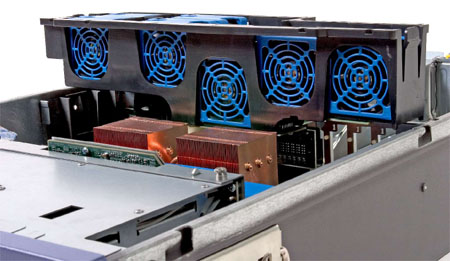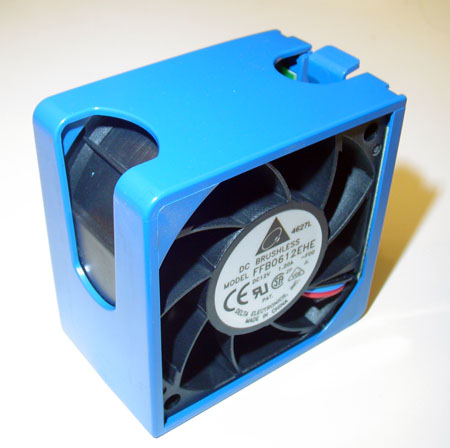Sun Fire V40z: Four Opterons in a 3U
by Kristopher Kubicki on February 22, 2005 12:05 AM EST- Posted in
- Systems
Thermals, Acoustic
Cooling four processors crammed into a 3U is not an easy process – particularly considering the fact that the V40z does not utilize any active cooling directly on their CPU heat sinks. As we mentioned earlier, the two forward Opterons under the hard drive bay use two low profile copper heat sinks; the two rear processors use 4” high copper heat sinks with heatpipe risers. All air must be pulled from the front intake of the system (below and through the hard drive bays) all the way to the rear power supplies before it is exhausted.The majority of cooling is provided by a bank of eight intelligent fans behind all four processors and another bank of four fans that sit between the forward and rear processors. In the image below, this bank is being removed from the system.
All of Sun’s cooling fans are modular. The 60mm brushless fans can be pulled out of the system and replaced without powering down the system; obviously a benefit if a fan dies. All of these fans are also accessible with the top panel removed, which means that we don’t have to pull a hard drive or power supply in order to replace a fan either.
Obviously, with twelve primary 60mm fans just providing the active cooling on the processors and memory, the Sun Fire V40z is not a quiet machine. Each redundant power supply also employs very loud fans, which gives the V40z a baseline operating noise level of 70 dBA even when the machine isn’t on. At a distance of twelve inches, we measured the Sun Fire V40z at a little over 85dBA. This is loud even by a rackmount standard, but in enterprise server configurations in dedicated server environments, this is certainly not a problem.
Even though the Sun Fire V40z is only 3U high, a standard 72-inch rack can only hold twelve V40z’s due to its thermal density, according to Sun documentation. Any more than twelve servers in a 72” rack wouldn’t allow for enough airflow.












38 Comments
View All Comments
tironside - Thursday, February 24, 2005 - link
I agree with dwnwrd. the lom part of it is not great for remote console etc. the lom that the hp stuff has is pretty slick, with a java / web interface. The other main problem I have with this is it offers only raid 1 unless you buy a rather expensive add on card to do raid 5, kind of a teaser to put 6 drive bays and only let you do raid 1... It's a good start, but sun needs to make some changes before it can go mission critical. (raid and lom enhancements imho) while I like cli stuff, trying to get junior people to do complicated cli stuff is dangerous...dwnwrd - Thursday, February 24, 2005 - link
I have some V20s and a V40. The service processor is pretty great except if you try to direct the Linux serial console to it then connect to the "serial over LAN" you'll get a flood of "serial8250: too much work for irq4" and a sleepy system.http://supportforum.sun.com/hardware/index.php?t=m...
Pontius - Thursday, February 24, 2005 - link
I am curious what they are using when they benchmark the linux kernel compile times. They use the time command which spits out three times - real, user & sys. Are they using the sum of all these? If not, something is wrong. Because I did the same test, on the same 2.6.4 kernel using -j2 on a dual 2.8GHz Nocona system and I got a "real" time of 147s. That doesn't seem right because the Opterons are way faster at compilation. On the other hand, if I take the sum of the 3 times, I get 420s. Any thoughts?jlee123 - Wednesday, February 23, 2005 - link
RedHat 9, are you joking!!?? This has got to be a mistake, I can't understand how Sun could be shipping a 64-bit server with a 32-bit OS that's reached End Of Life. It's the equivalent of buying a workstation with Windows ME on it. Also, there was never a official port of RH9 to x86-64, the first x86-64 RedHat was RHEL3, the Fedora team later released FC1 x86-64. If Sun doesn't wish to pay licensing, they'd be better off shipping with FC2, FC3 or CentOS, a free rebuild of RHEL. This hardware isn't even going to begin to be utilized till it's running something more modern like RHEL4 x86-64.JustAnAverageGuy - Wednesday, February 23, 2005 - link
I could think of one use for these. :)http://forums.anandtech.com/categories.aspx?catid=...
lauwersw - Wednesday, February 23, 2005 - link
Standard rule for parallel make is to use 2xnumber of processors available. This gives most optimal results to hide disk latencies and seems to be correct in most cases I've seen.phaxmohdem - Wednesday, February 23, 2005 - link
Call me what you will, but I would like to see some quad/dual Xeon scores to compare to as well (along with price tages for comparison :) )And yes, If I were a rich man who knew what to do with that much computing power, I would have a dozen of these babies in my basement! Who needs women anymore once you have 48 Opteron x50 or x52 cpus humming at your disposal. And drool core? Ahhhhhhhhhhh.
JustAnAverageGuy - Tuesday, February 22, 2005 - link
That thing is a BEAST.I have no idea what I'd do with a computer like that.
MrEMan - Tuesday, February 22, 2005 - link
Kristopher,Thanks for the clarification about the reduced media tag.
E
KristopherKubicki - Tuesday, February 22, 2005 - link
RyanVM: The system used 850s.Kristopher